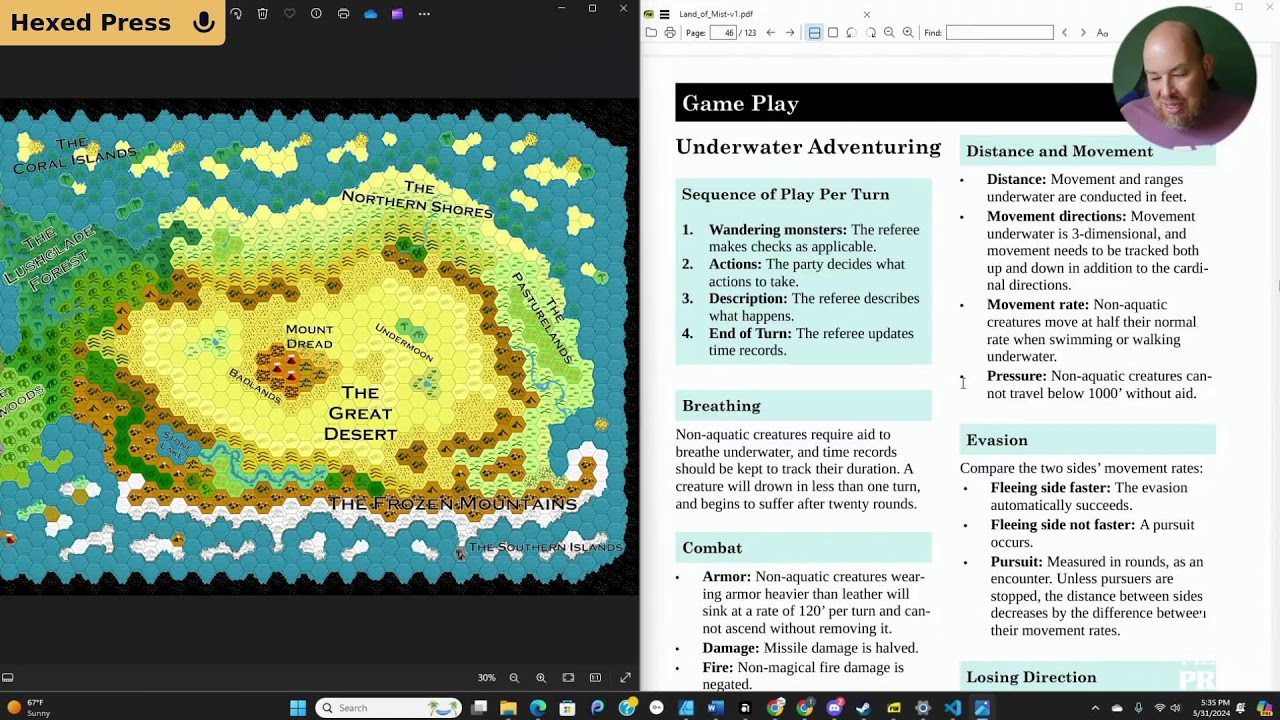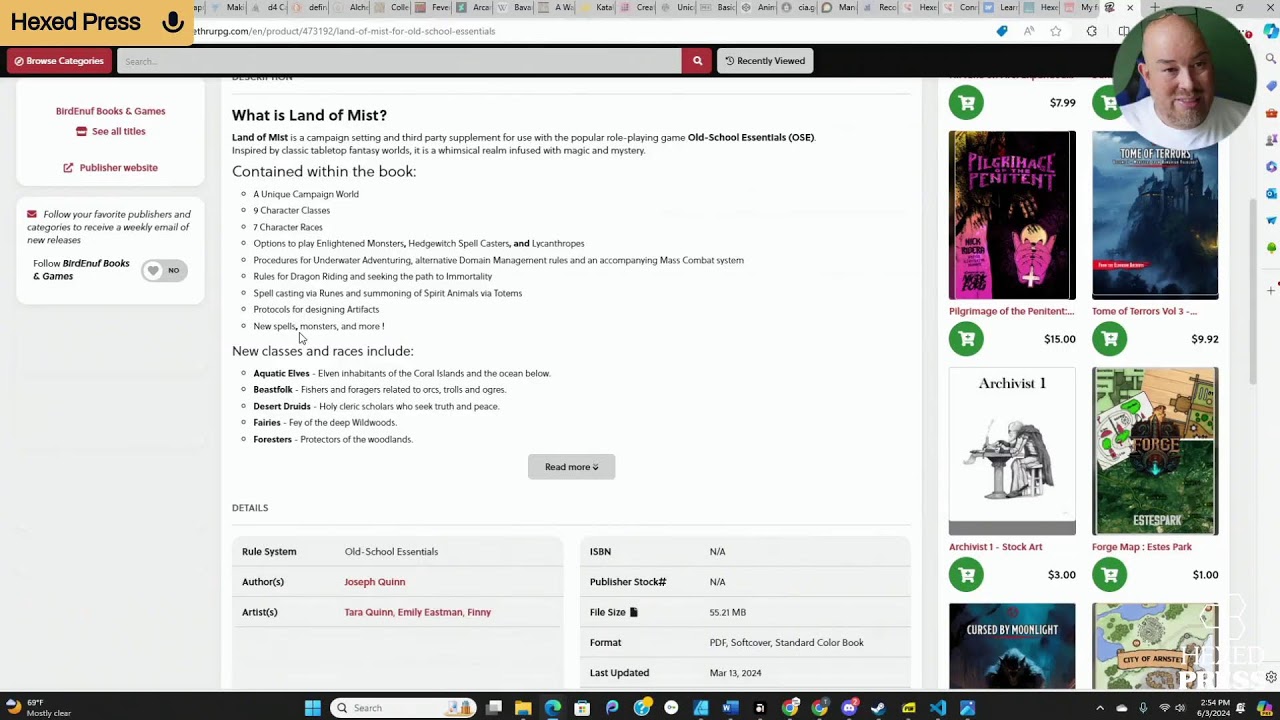“Land of Mist is a campaign setting and third party supplement for use with the popular role-playing game Old-School Essentials (OSE). Inspired by classic tabletop fantasy worlds, it is a whimsical realm infused with magic and mystery.”
Hello, this is the author of Land of Mist. Thank you very much for taking the time to read through the book and share it with your audience, I really appreciate it!
I enjoyed watching the two videos and hearing your take on the book, and wanted to respond to those areas where you voiced questions or comments.
- Elevation - The Great Desert is a high desert plateau (as opposed to a crater).
- The Mist - Does not trap inhabitants within, but any who pass through (at least into Land of Mist) will be affected by the Forgetting.
- The Forgetting - Affects not only memories, but objects.
- Map scale - Intentionally left officially undefined, but I had in mind an island continent on the scale of Australia or an iceless Antarctica, and used a 24 miles/hex scale as my reference.
- Immortals - More than mortals, less than deities. The only being with the power of a deity in the setting is the Mist.
- Totems - Before reaching a level where a totem animal can be summoned, you gain the benefit of remaining unharmed by the animal type and a responsibility to roleplay a connection to the animal.
- Underwater adventuring - Admittedly somewhat gamified, inspired by expanded BECMI rules. In Land of Mist, I would expect this section to be used mostly by Aquatic Elves and waterborne Enlightened Monsters, thus the various considerations that apply only to non-aquatic creatures. The “Shopping under the Sea” breakout is mostly for flavor, and Sharkskin armor can be assumed leather equivalent.
- Desert Druid - Inspired by expanded BECMI rules, the Desert Druid or whirling dervish, thus the agility abilities. OSE does not give clerics spells at first level, but they do the druid in Advanced Fantasy.
- Fairy - Random spells are unique to the Fairy, which rolls each day and has an accelerated spell progression.
- Forester - Inspired by the expanded BECMI rules class of the same name.
- Moon Drow - Can cure lycanthropy at any time, so long as it is before the subject’s transformation is complete.
- Mystic - A monk type class, inspired by the BECMI/RC class of the same name.
- Enlightenment - It is expected (and stated) that the referee will work to modify the abilities of the monster type for the player. To aid balance, special abilities represented by asterisks will affect XP required to level and maximum level. There is an assumption that monsters less than 1HD are “small” (and thus receive an AC bonus abilility similar to the halfling) and 4HD are “hardy” (thus their AC bonus). I defined the XP required to level on the high side expecting some monster abilities would be included. There are some examples in the appendix to help provide guidance.
- Lycanthrope - In addition to the chosen Ability and Affliction, there is a default of each also included to allow changing to the animal form, both voluntarily and involuntarily respectively.
- Downtime - Meant to be a framework for bookkeeping and a bit of RP in circumstances where you might wait out weeks or months in the game (healing, magical research, etc.). The challenges system is inspired by ICRPG’s effort system.
- Domain Management - The default rules in OSE revolve around a single player becoming a domain ruler, thus the Ruling Council option is mentioned explicitly. This section is inspired by a combination of BECMI/RC domain management rules and wargaming.
- Dragon riding / mist dragons - There’s a bit more detail in the Mist Dragon monster descriptions themselves. As noticed, they start out at low level far less powerful than dragons generally. They can be thought of as sort of over-sized fairy dragons. The amber dragon’s charm monster ability is admittedly powerful, but the others certainly can be as well. Sleep for instance allows for an unopposed one hit kill, and continuous darkness is eternal. The training of the dragon is one of several areas that are intentionally meant to be a bit of a gold-sink, something of an answer to the question of what to do with all the gold you acquire while gaining XP. Keeping the dragon continuously at one level below your character would require you spend more than you will likely bring in. I suppose a referee could allow you to buy more than one dragon, but you could only ride (and thus control) one at a time, and it would be quite expensive to pay to level several.
- Immortality - I actually did consider allowing some form of modifier to the save-versus-death, but ultimately decided that immortality is such as serious matter it should always entail the ultimate risk. It gives a bit of a nice advantage to demihumans as well, with their superior saving throws, which I feel helps balance their lower level caps.
- Artifacts - As opposed to “normal” magic items, these are created by immortals and not meant for mortal use. Inspired by the BECMI/RC rules. For lower power level artifacts, there is by character experience level 3 a 50% chance or better of success, so generally beneficial. For higher level artifacts, not so much.
- Setting detail - Intentionally minimalistic. I decided early on to avoid proper names and lean into “generification”, the goal being to create an “everything but the kitchen sink” fantasy world with lots of room to be moulded by the referee. I actually went back and forth quite a bit on the idea of even including a map, and ultimately did so because I really wanted to create one and was happy with the result. Regions, peoples, communities, and cults are included, with various hints and flavor sprinkled throughout the book. Referees may use the setting on the scale they wish and populate or leave as wilderness those areas that fit the campaign they want to run.
Broadly, what I wanted to do with this product was bring over character and gameplay options from the expanded BECMI rules, in a manner akin to the old BECMI supplements, in the minimalist presentation of OSE. It was rather a staple of the setting books of that era to bring with them new classes, spells, rules, monsters and so on. The Carcass Crawler comparison is fair (though content-wise this is about the size of 3 or 4 of them).
Welcome aboard and thanks so much for chiming in! I appreciate all the added context!
Aha! I wonder if it would make sense to highlight this more? Rather than position it as a setting primarily, call it out as a rules expansion in the flavor of the BECMI books?
I have avoided highlighting the BECMI angle explicitly for a few reasons, one of which being that I think it comes with its own expectations such as leveling to 36 (better served by other’s products like B/X Companion). I have gone ahead and updated references on the DTRPG product pages from “campaign setting” to “campaign backdrop” in response to your commentary though.
I don’t know how big of an issue the level bit would be (plus it seems most folks consider that the weakest part of BECMI ![]() ) but I can empathize with the quandaries involved in trying to position your work where you want it!
) but I can empathize with the quandaries involved in trying to position your work where you want it!
In terms of the setting, it’s got some interesting bones! I’d love for you to delve into it-- gazetteer style-- and really flesh it out. For example, I’d love to know more about the mind of the mist, what the actual cultures in the land are like (and how BIG is the land anyway? 24 miles/hex I forgot!), and how those cultures have adapted to the presence of dragonriders!
I’ll definitely be keeping your input in mind. At the end of the day it’s my responsibility to inform people on what they’re getting, and this exercise is evidence I could do better.
I do have some ideas of adventures I’d like to release for the setting in the future, and I’ll be sure to let you know if I do!

